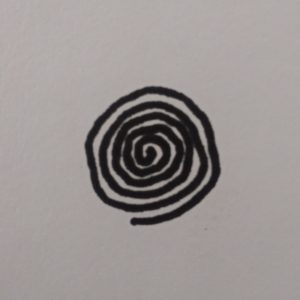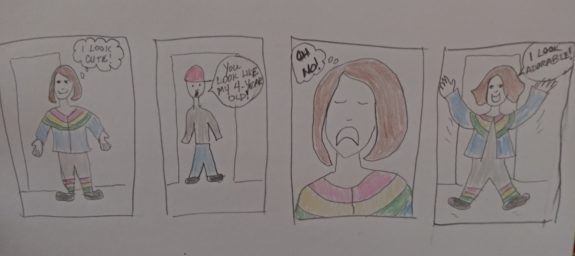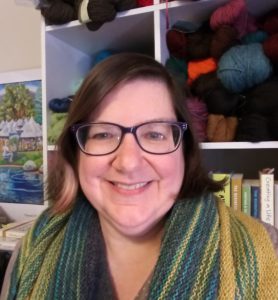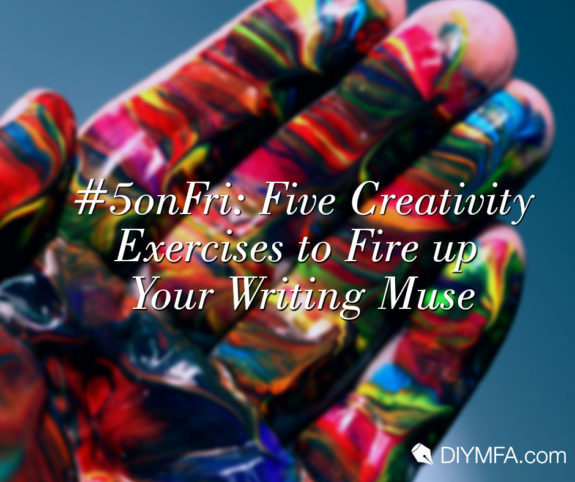We think of inspiration arriving in a flash, a moment where the rabbit appears from the magic hat as if from nowhere. Those creative lightning strikes hit each of us occasionally. We know we can’t rely on their appearance. But what if we could? Creativity exercises foster conditions that make inspirational lightning strikes more likely.
You see, our minds continually try to find patterns, manifesting dogs in clouds and faces on potatoes. Our brains want to find the order of a pattern in the chaos of our experience. This need promotes the formation of new connections. By introducing yourself, your mind, your body to new patterns, you can find inspiration anywhere and anytime.
Creativity exercises encourage these new connections. Here are some of my favorites to fire up my writing muse and get my fingers typing.
1. The Spiral Meditation
Does your day fill quickly with distractions? Mine does—lists of tasks to complete, books to read, calls to make. My being calls out for peace, and I know that if I can’t get back to center again, I won’t be productive.
In these circumstances, I perform my spiral meditation. To do this meditation, you need a pen, a blank page, and some quiet music or a soothing voice recording. Keep your journal nearby as well.
Find a quiet space, somewhere you can isolate yourself from distraction. If disturbing noises are unavoidable, put on your headphones.
Begin by hitting play on your selected song or reading.

Using your pen, start at the center of your blank page and draw a spiral. Make the lines as close together as you can without the lines touching. Do not lift your pen from the page. Continue to draw the spiral for the entire song or until your soothing voice has read to you for a few minutes. Just a few moments of this activity calms the mind and centers your soul.
Once the song or reading is over, put down the pen and close your eyes. Let your mind clear. If thoughts intrude, allow them to drift away. Refocus your mind on that nothingness. Stay in this state for as long as you want.
When you open your eyes, take a moment and write any thoughts that entered your mind during your meditation. Return to your writing work with a new focus, ready to embrace the messages from your writing muse.
2. Make a Comic Strip
Even if you don’t think you can draw, you can make a comic strip! This exercise flips your brain by making you look at your work through pictures and the briefest of words. Making a comic strip forces you to confine your work into four squares. Drawing pictures encourages you to view your work from another angle.
Give it a try by working on a scene from your story or practice on an event that happened to you in the past week. What caught your eye and your imagination? Did the Batmobile pass you on the highway? Maybe you made a joke with the cashier at the grocery store. Use that happening to inspire your cartoon.
On a blank piece of paper, draw four squares and tell your story with pictures drawn inside them. Here’s mine:

You don’t have to be Michelangelo. Have fun!
3. The Most Precious Possession
Do you need to flesh out a character? Maybe you want to create someone brand new. The Most Precious Possession uses an object to develop a character filled with quirks.
Reach into your junk drawer and select a random object. Pretend that it is the most precious possession of someone. Describe that person—give them a name, a way of dressing, a place to live. Tell the story of how that thing became their most precious possession.
If you have a character that you’re struggling with, you might already have identified their most precious possession. Conjure up the picture of the thing in your mind and follow the same formula. For instance, does your main character have a stalker? Your main character is that stalker’s most precious possession. Delve into the darkness, joy, and madness that makes it happen. You’ll discover a lot about the stalker, and probably more about your main character than you realized before.
This exercise works quite as well with your character’s bejeweled necklace or tattered old sweater.
4. Do Your Verbs
Do Your Verbs combines creativity and physicality. To play along, pick an action verb and then mime doing it. Experiment with all of the ways you could possibly do this verb. For example, let’s say you pick “Run” as your verb. Jog slowly, an out-of-shape person resolving to strengthen their bones. Leap like a gazelle across the savannah. Scurry like a mouse escaping a cat.
Use this exercise to develop your action in a scene. Pluck an action out of the scene and physically perform it. Feel the difference as you play with the variations. Bring your character to life and embody the ways the scene could go depending on how they move. Take those motions and describe them on the page.
Having the physical memory of the action in your body brings specificity to your words, drawing a visceral picture for your reader. Reading that your character disobeyed his mother is different from reading that he “defied” her or he “sneaked around” her. This exercise helps you define those subtleties.
A great resource to accompany this exercise is Actions: The Actors’ Thesaurus. Filled with action verbs, this book delivers a myriad of options.
5. Be a Creative Outlaw
Sometimes, you need to break some rules. If you are stuck in a scene, can’t dream up a new idea, or just aren’t feeling it today, try being a creative outlaw!
You know that story that you don’t think you’re talented enough to write? Write it anyway.
How about the incredibly inappropriate one? You know it—it’s not age or gender or skin appropriate, but it took your heart and won’t let go. Write the words anyway. Free it from your soul.
Pick your most indulgent, treasured, precious idea and begin. Drop your other projects. Swing into this new idea and plunder it like a swashbuckling archaeologist digging through a tomb.
Be responsible tomorrow. And maybe burn the inappropriate story.
Creativity Exercises Fire Up Your Muse
Bring new life to your work with these creativity exercises. Not all of them may work for you, but experimenting sure is fun!
Of course, these are just the tip of the iceberg. You can find more in books like The Creative Habit: Learn It and Use It for Life (Twyla Tharp invented the “Do a Verb” exercise) and The Awe-Manac. I learned a version of “Most Precious Possession” from the knitting innovator, Cat Bordhi.
You may never know when your muse will appear, but you can invite her to play. Use creativity exercises to fire up your imagination and get your fingers writing!
Bibliography:
Badonsky, Jill. The Awe-Manac. Running Press Book Publishers, 2008.
Caldarone, Marina and Lloyd-Williams, Maggie. Actions: The Actors’ Thesaurus. Drama Publishers, 2004.
Tharp, Twyla with Reiter, Mark. The Creative Habit: Learn It and Use It for Life: A Practical Guide. Simon & Schuster, 2003

LA (as in tra-la-la) Bourgeois coaches writers, makers, and other creatives to grow their creative businesses and break away from their day jobs! As a creativity & business coach, she believes that exploring your creativity invites joy into your life, embracing your creativity infuses your life with joy, and manifesting your creativity gives you a joyous purpose. Writing and knitting are her nonnegotiable mediums, and she can usually be found with a pen or knitting needles in her hands. Find her free guide, “Tricking Yourself into a Creative Habit” online at labourgeois.biz and start writing those words today. She can’t wait to read them!







